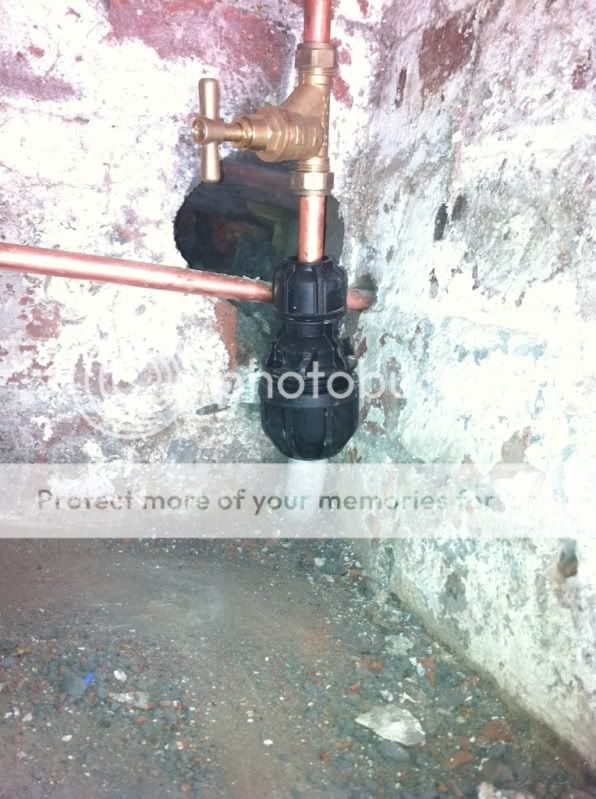No, as I've said, I don't. That's why (despite all the ridicule it seems to generate) I want the pipework in my house explicity bonded to the electrical installation's MET
As do I. The idea that the pipework can be treated as a small, isolated item which can be dealt with by supposed segregation doesn't add up. It's not just a metal door handle or something equally trivial. The chances of the latter becoming energized by some means are extremely remote. You might manage it if you draped a damaged appliance cord over the handle, but even if that happened, it would be only the handle itself which would be live (O.K., and probably the matching handle on the other side of the door via the metal bar connecting them).
The water pipework in the house extends over a much greater area, and is not so easily segregated. If you drape a damaged kettle lead over a metal kitchen tap, do you want that to leave not only the kitchen tap live but also exposed pipework running on walls in a utility room, and taps in that utility room and bathroom to be live, when there will be other earthed metalwork right next to it, such as from a washing machine, dryer, or similar appliance?
You would need to maintain very strict electrical isolation of various sections of the pipework to prevent that from happening. Unless you went to great lengths to provide suitable insulation during installation, you would still have all sorts of stray paths to earth via parts of the building.
And what happens when somebody just pushes an earthed, metal-cased appliance up against some piece of exposed pipework or a radiator? What happens to that segregation then?
I'm not sure it's totally the fault of those here, since they are being 'fed' by the apparent requirements of BS7671.
The notion that the pipework need not be bonded seems very new, perhaps fueled by the apparent vagueness which has crept into BS7671 and the belief that somehow the pipework can be treated as a small, isolated piece of metalwork which can be handled by segregation, even though it's impractical to so segregate it.
Older editions of what were then just the IEE Wiring Regs. made it perfectly clear that the pipework in the house is a substantial piece of extraneous fixed metalwork which needs to be bonded. Here are the applicable regulations from the 14th edition:
D.10 The consumer's earthing terminal required by Regulation D.2 shall be bonded to the metalwork of any gas or water services on the consumer's premises in accordance with regulations D.11-13.
{.....}
D.12 The bonding connections to any gas or water services shall be made as near as practicable to the point of entry of those services into the premises; provided that where there is an insulating section or insert at that point, the connection shall be made to the metalwork on the consumer's side of that section or insert.
{.....}
D.14 The exposed metalwork of all apparatus which is required by these Regulations to be earthed, which might otherwise come into fortuitous contact with extraneous fixed metalwork shall be either effectually segregated therefrom or effectually bonded thereto so as to prevent appreciable voltage differences at such possible points of contact (see also Regulation B.53).
NOTE 1. - The extraneous fixed metalwork required to be bonded and earthed in these circumstances includes the following:
(i) Baths and exposed metal pipes, radiators, sinks and tanks, in the absence of metal-to-metal joints of negligible electrical resistance.
(ii) Where practicable, accessible structural steelwork.
(iii) Framework of mobile equipment on which electrical equipment is mounted, such as cranes and lifts.
NOTE 2. - There are special requirements for bonding to metalwork of other services in P.M.E. installations (see Regulation D.34(iii) and Item 4(2) of Appendix 5).
How have we gotten from this clear requirement to bond the pipework to the present situation where some people seem to think that it's unnecessary?
Yet some of those who want to leave the substantial amount of extraneous fixed metalwork which forms the water system of the house unbonded will start (metaphorically) jumping up and down at the thought of having a metal light fitting on an unearthed lighting circuit, even though the risk it poses is substantially smaller, being a single item, generally mounted out of general reach, and where any fault in the fitting would leave only that fitting itself live.
bernardgreen said:
Do the regulations say anything about connecting the MET of a PME system to an earth rod ?
I can recall being told that connecting the neutral derived "earth" of a PME supply to an earth rod was not permitted.
I had an argument with somebody on another forum some time ago over this very subject, and he was trying to insist that it was outright dangerous and that it was somehow creating a "hybrid" earthing system which was a cross between TN-C-S and TT. Yet he was quite happy for the neutral/earth of a TN-C-S system to be bonded to a metallic water pipe buried in the ground. Nothing would convince him that the water pipe would be acting just as much as an earth electrode as a rod driven into the ground specifically for the purpose (and probably providing a lower impedance path anyway if of substantial length).
In other parts of the world where TN-C-S is the norm, a local earth electrode is
required to be connected to the incoming neutral.


